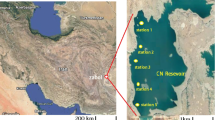Abstract
Freshwater green algal biofouling of boats refers to the accrual of freshwater green algae on boats immersed in water. The current research focused on the morphological characteristics of the isolates, species ecology, and the physicochemical properties of the water at the sampling sites. Two localities, Haji Zai and Sardaryab, were sampled at the Kabul River in the district of Charsadda, Pakistan. Freshwater green algae causing biofouling were isolated from the boats. A total of three genera: Cladophora, Rhizoclonium, and Spirogyra with fifteen species belonging to the families Cladophoraceae and Zygnemataceae were observed. Statistical analysis reveals significant stimulation of green algal species in the boats’ fouled communities by increases in water temperature, conductivity, and Total Suspended Solids (TSS). The algal growth at the Haji Zai site is suppressed by TDS in autumn (Pearson −0.56) and is stimulated by water temperature in spring (Pearson 0.44). At the Sardaryab site, algae were stimulated in spring by pH of water (Pearson 0.61), and suppressed by Total Dissolved Solids (TDS) in autumn (Pearson −0.43). Statistical analysis indicates that pH, conductivity, and temperature are the main factors determining the algal biofouling in the Kabul River.
Similar content being viewed by others
References
Andrewartha, J.M. (2010). The effect of freshwater biofilms on turbulent boundary layers and the implications for hydropower canals. Unpublished doctoral dissertation, School of Engineering, University of Tasmania, Australia.
Awad, M.M. (2011). Fouling of Heat Transfer Surfaces. In A. Belmiloudi (Ed.), Heat Transfer — Theoretical Analysis, Experimental Investigations and Industrial Systems (pp. 505–542). Cairo, Egypt: InTech. Retrieved August 13, 2014 from http://cdn.intechopen.com/pdfs/13202/InTech-Fouling_of_heat_transfer_surfaces.pdf accessed 30.11.2013, 17:00 GMT.
Barinova, S., Naiz Ali, Barkatullah and F.M. Sarim. (2013). Ecological Adaptation to Altitude of Algal Communities in the Swat Valley (Hindu Cush Mountains, Pakistan). Expert. Opin. Environ. Biol. 2(2): 1–15. doi:10.4172/2325-9655.1000104.
Bellinger, E.G. and Sigee, D.C. (2010). Freshwater algae: identification and use as bioindicators. Chichester, UK: John Wiley and Sons.
Biggs B.J.F. 2000. Eutrophication of streams and rivers: dissolved nutrient-chlorophyll relationships for benthic algae. Journal of the North American Benthological Society 19: 17–31.
Bourassa N., Cattaneo A. 1998. Control of periphyton biomass in Laurentian streams (Quebec). Journal of the North American Benthological Society 17(4): 420–429.
Callow, M.E. (1986). A world-wide survey of slime formation on anti-fouling paints. Studies in Environmental Science 28: 1–20.
Callow, M.E. and Callow, J.A. (2002). Marine biofouling: a sticky problem. Biologist 49(1): 1–5.
Collins, F.S. (1909). The green algae of North America. Tufts College Studies 2(3): 79–480.
District census report. (1998). District Charsadda. Population census organization Islamabad. Islamabad: Government of Pakistan.
Dürr, S. & Thomason, J. (2010). Biofouling. Oxford: John Wiley and Sons.
Edler, L. & Elbrächter, M. (2010). The Utermöhl method for quantitative phytoplankton analysis. In B. Karlson, C. Cusack & E. Bresnan (Eds.), Microscopic and molecular methods for quantitative phytoplankton analysis (pp. 13–20). Paris: UNESCO Publishing.
Evans, L.V. & Hoagland, K.D. (Eds.). (1986). Algal biofouling. Amsterdam: Elsevier.
Flemming, H.C. (2002). Biofouling in water systems: cases, causes and countermeasures. Applied microbiology and biotechnology 59(6): 629–640.
Jenner, H.A., Whitehouse, J.W., Taylor C.J.L. & Khalanski, M. (1998). Cooling water management in European power stations: Biology and control of fouling. Hydroécologie Appliquée 10: 1–255.
Kuwabara, J.S. (1986). Physicochemical processes affecting copper, tin and zinc toxicity to algae: A review. Studies in Environmental Science 28: 129–144.
Lagalice, C.G. (2006). Studies on the marine fouling alga Ectocarpus siliculosus. Unpublished B.Sc (Hons) thesis, School of biological sciences, University of Portsmouth, Portsmouth, UK.
Lee, R.E. (2008). Phycology. Cambridge: Cambridge University Press.
Loeb, S.L. (1986). Algal biofouling of oligotrophic Lake Tahoe: Causal factors affecting Proouction. Studies in environmental science 28:159–173.
Melo, L.F. & Bott, T.R. (1997). Biofouling in water systems. Experimental thermal and fluid science 14(4): 375–381.
Padisák, J., Ács, É., Rajczy, M. & Kiss, K.T. (1991). Use of algae for monitoring rivers in Hungary. In: Whitton, B.A., Rott, E. & Friedrich, G. (Eds.). Use of algae for monitoring rivers. Innsbruck: Institut für Botanik Univ Press: 123–128.
Perkins, K.J., Andrewartha, J.M., McMinn, A., Cook, S.S. & Hallegraeff, G.M. (2010). Succession and physiological health of freshwater microalgal fouling in a Tasmanian hydropower canal. Biofouling: The Journal of Bioadhesion and Biofilm Research 26(6): 637–644.
Prescott, G.W. (1962). Algae of the Western great lakes area. Dubuque, Iowa USA: W.M.C. Brown Company Publisher.
Railkin, A.I. (2004). Marine biofouling: Colonization process and defenses. Boca Raton: CRC press.
Teng, F., Guan, Y.T. & Zhu, W.P. (2008). Effect of biofilm on cast iron pipe corrosion in drinking water distribution system: corrosion scales characterization and microbial community structure investigation. Corrosion science 50(10): 2816–2823.
Ter Braak, C.J.F., Šmilauer, P. (2002). CANOCO Reference Manual and CanoDraw for Windows User’s Guide: Software for Canonical Community Ordination (version 4.5). Ithaca: Microcomputer Power Press.
Transeau, E.N. (1951). The Zygnemataceae. Columbus: Ohio State University Press.
Ullah, Z., Khan, H., Waseem, A., Mahmood, Q., Farooq U. (2013). Water quality assessment of the River Kabul at Peshawar, Pakistan: Industrial and urban wastewater impacts. Journal of Water Chemistry and Technology 35(4): 170–176.
Author information
Authors and Affiliations
Corresponding author
About this article
Cite this article
Khuram, I., Ahmad, N., Jan, S. et al. Freshwater green algal biofouling of boats in the Kabul River, Pakistan. Ocean and Hydro 43, 329–336 (2014). https://doi.org/10.2478/s13545-014-0150-y
Received:
Accepted:
Published:
Issue Date:
DOI: https://doi.org/10.2478/s13545-014-0150-y




